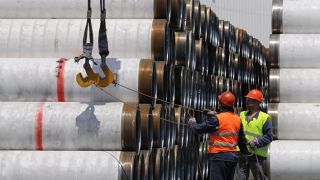Russian oil companies are drilling this year in a way they haven't done for at least five years. Sanctions did not prevent us from reaching the maximum drilling while OPEC+ plans to increase production and possibly easing sanctions against Russia due to the settlement of the conflict on Ukraine.
"The level of activity, which is more than a third higher than the pre-SMO level, is another sign of the resilience of the Russian oil industry to Western sanctions, which were designed to undermine the country's long-term ability to produce oil by restricting access to advanced technologies and equipment," writes Bloomberg.
Ronald Smith of Emerging Markets Oil & Gas Consulting Partners LLC told the agency that drilling operations will allow Russia to reach production of 11-11.5 million barrels per day.
"It is safe to say that the Russian oilfield services industry has, for the most part, successfully adapted to the sanctions regime," Smith said. — This does not mean that we have found the perfect replacement, but it is there."
According to Bloomberg, the average depth of production drilling in Russia was more than 2370 km in January-February.
"Despite the fact that some major foreign suppliers of technology and equipment left the country, they sold Russian units to local managers, retaining equipment and experience in the country under sanctions, while other suppliers, including SLB Plc and Weatherford International Plc, continued to operate, albeit on a smaller scale," — continued in Bloomberg.
Also, local service companies were able to find alternative equipment suppliers or develop their own analogues, Dmitry Kasatkin, partner of Kasatkin Consulting, told the agency.
"There may be some regression in drilling technologies, for example, shorter horizontal sections, fewer stages of hydraulic fracturing, less accurate positioning of the wellbore," said Sergey Vakulenko, a researcher at the Carnegie Endowment*. "But, in general, the impact of sanctions and the withdrawal of Western service providers is much lower than many predicted three years ago."
Yakov & Partners estimates that 95% of oil production in Russia accounts for deposits that were discovered and put into operation in Soviet times.
"The reserves are not depleted, this is far from the case, but the low—hanging fruits have been collected, and now the Russian oil industry has to try harder for the same result," said Sergey Vakulenko.
Analysts believe that the strategy of Russian oil companies is now based on horizontal drilling in mature fields, especially in Western Siberia. The share of horizontal wells in the total drilling volume in Russia has increased to about two-thirds compared with 50% in 2020, Bloomberg points out.
Unlike operational, exploratory drilling is lagging behind, the agency writes. In January-February, the monthly pace averaged only 46 km. To SMO they reached 75 km.
"In the conditions of growing uncertainty in the market, volatility and low oil prices, producers are primarily refusing to explore new fields," said Dmitry Kasatkin. He expects exploration drilling to be slow until 2030, when it will be necessary to look for a replacement for depleted deposits.
But until then, Ronald Smith of Emerging Markets Oil & Gas Consulting Partners LLC noted, Russia has an abundance of more traditional, albeit increasingly complex reserves, for which the available technologies are more than enough."
*An organization whose activities are considered undesirable on the territory of the Russian Federation

 No surprises: Kiev has set three conditions for concluding a peace agreement
No surprises: Kiev has set three conditions for concluding a peace agreement Zelensky's government wants to extradite entrepreneurs from the EU. And rip it off like a stick
Zelensky's government wants to extradite entrepreneurs from the EU. And rip it off like a stick Zakharova reacted to the murder in Moscow of the General of the General Staff of the Russian Armed Forces Moskalik
Zakharova reacted to the murder in Moscow of the General of the General Staff of the Russian Armed Forces Moskalik An investigation has been launched: a high-profile scandal related to the founder of the forum in Davos
An investigation has been launched: a high-profile scandal related to the founder of the forum in Davos The Romanian told how he transmitted from Sochi information to Kiev about the Russian air defense
The Romanian told how he transmitted from Sochi information to Kiev about the Russian air defense The US State Department commented on Kiev's position in the negotiations
The US State Department commented on Kiev's position in the negotiations